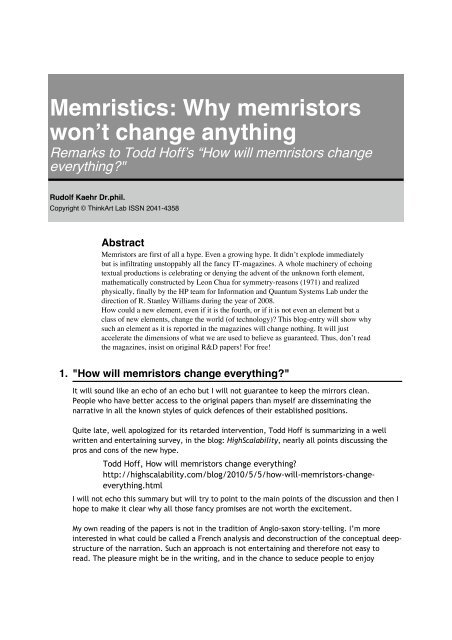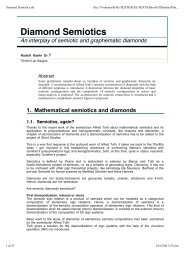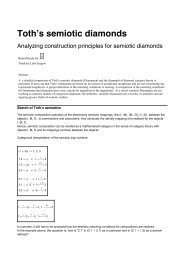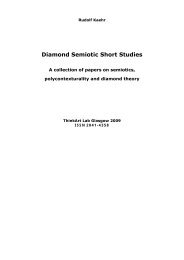Why-Not (PDF) - Memristics
Why-Not (PDF) - Memristics
Why-Not (PDF) - Memristics
You also want an ePaper? Increase the reach of your titles
YUMPU automatically turns print PDFs into web optimized ePapers that Google loves.
«<br />
„<br />
<strong>Memristics</strong>: <strong>Why</strong> memristors<br />
won’t change anything<br />
Remarks to Todd Hoff’s “How will memristors change<br />
everything?"<br />
Rudolf Kaehr Dr.phil.<br />
Copyright © ThinkArt Lab ISSN 2041-4358<br />
Abstract<br />
Memristors are first of all a hype. Even a growing hype. It didn’t explode immediately<br />
but is infiltrating unstoppably all the fancy IT-magazines. A whole machinery of echoing<br />
textual productions is celebrating or denying the advent of the unknown forth element,<br />
mathematically constructed by Leon Chua for symmetry-reasons (1971) and realized<br />
physically, finally by the HP team for Information and Quantum Systems Lab under the<br />
direction of R. Stanley Williams during the year of 2008.<br />
How could a new element, even if it is the fourth, or if it is not even an element but a<br />
class of new elements, change the world (of technology)? This blog-entry will show why<br />
such an element as it is reported in the magazines will change nothing. It will just<br />
accelerate the dimensions of what we are used to believe as guaranteed. Thus, don’t read<br />
the magazines, insist on original R&D papers! For free!<br />
1. "How will memristors change everything?"<br />
It will sound like an echo of an echo but I will not guarantee to keep the mirrors clean.<br />
People who have better access to the original papers than myself are disseminating the<br />
narrative in all the known styles of quick defences of their established positions.<br />
Quite late, well apologized for its retarded intervention, Todd Hoff is summarizing in a well<br />
written and entertaining survey, in the blog: HighScalability, nearly all points discussing the<br />
pros and cons of the new hype.<br />
Todd Hoff, How will memristors change everything?<br />
http://highscalability.com/blog/2010/5/5/how-will-memristors-changeeverything.html<br />
I will not echo this summary but will try to point to the main points of the discussion and then I<br />
hope to make it clear why all those fancy promises are not worth the excitement.<br />
My own reading of the papers is not in the tradition of Anglo-saxon story-telling. I’m more<br />
interested in what could be called a French analysis and deconstruction of the conceptual deepstructure<br />
of the narration. Such an approach is not entertaining and therefore not easy to<br />
read. The pleasure might be in the writing, and in the chance to seduce people to enjoy<br />
reading such analysis of the deep-structure of scientific and technological narratives, which are<br />
not specially welcomed. Some people are even afraid to get cheated by a kind of a neo-<br />
Sokalism.<br />
Now, what are all those changes, the memristor invention/intervention will force on us in the<br />
near future?
I will not echo this summary but will try to point to the main points of the discussion and then I<br />
hope to make it clear why all those fancy promises are not worth the excitement.<br />
My own reading of the papers is not in the tradition of Anglo-saxon story-telling. I’m more<br />
interested in what could be called a French analysis and deconstruction of the conceptual deepstructure<br />
Name of the narration. Such an approach is not entertaining and therefore not easy to<br />
2 Author<br />
read. The pleasure might be in the writing, and in the chance to seduce people to enjoy<br />
reading such analysis of the deep-structure of scientific and technological narratives, which are<br />
not specially welcomed. Some people are even afraid to get cheated by a kind of a neo-<br />
Sokalism.<br />
Now, what are all those changes, the memristor invention/intervention will force on us in the<br />
near future?<br />
Faster, smaller, cheaper: Without this programmed reflex to everything possibly new, nothing<br />
is working. There will be no support from academies, companies, military and post-humanists<br />
of the future of the human race, if the criteria of “Faster, Smaller, Cheaper” are not promised<br />
and realizations of it not guaranteed to be accessible in the near(est) future.<br />
2. Memristors, what do we know until now?<br />
2.1. The claims<br />
"Let's assume for the sake of dreaming memristors do prove out.”<br />
[All citations from: Todd Hoff, How will memristors change everything?]<br />
"I don't know, but it's worth thinking about, especially if you want to ride the wave of the next<br />
decade's technological revolution (Bell's Law of Computer Classes). If you are looking to get<br />
ahead of the next revolution this just might be it. And as almost always revolutions are based<br />
on building a new material based on a fundamental discovery of how the world works. The<br />
memristor is such a material and discovery.”<br />
"I will do a lot of ‘not pretending’ in this article. I won't pretend I actually understand what<br />
memristors are or how they will change everything."
Article Title 3<br />
2.2. The promises<br />
It Replaces RAM, Flash and Disk<br />
"Memristors are nano devices that remember information permanently, switch in nanoseconds,<br />
are super dense, and power efficient. That makes memristors potential replacements for<br />
DRAM, flash, and disk.”<br />
"The characteristics of memristors are such that you have to rethink the whole compute and<br />
storage paradigm. How will it change your designs if you can have large enough amounts of<br />
SRAM like storage on the microprocessor such that you don't need DRAM?”<br />
It Requires Change<br />
"People love progress but they hate change. Memristors require change. They are not a plug<br />
compatible technology. You can't just drop a memristor chip or RAM module into an existing<br />
system and have it work. It will take a system redesign. The question is when will the pain<br />
point in industry be sufficient to cause a migration to a new technology?”<br />
It is Big<br />
"How much storage are we talking about on a single chip? With an invention they hail as<br />
important as the memristor is a new architecture that allows the stacking of multiple crossbar<br />
memories on top of each other.”<br />
It Computes<br />
"Memristors are not just stuck in they past, they don't just remember, they can perform logic!”<br />
"But it turns out memristors naturally implement something called material implication logic,<br />
which can be interconnected to create any logical operation, much the same way NAND gates<br />
were used to build early supercomputers because they were easier to build.”<br />
"So what we have now is a material that can be dynamically configured on the fly to act as<br />
either memory or CPU.”<br />
It Flattens the CPU Memory Hierarchy Divide<br />
"Williams claims that dynamically changing memristors between memory and logic operations<br />
constitutes a new computing paradigm enabling calculations to be performed in the same chips<br />
where data is stored, rather than in a specialized central processing unit.”<br />
It Learns<br />
"They are also exploring the emulation of brains because the properties of the memristor<br />
apparently mimic neurons and can learn without supervision. Synapses and axons are both<br />
effectively memristors.”<br />
"The conclusion is: Put the computation near the data."
4 Author Name<br />
2.3. The facts<br />
It Doesn't Exist<br />
"Yes, there's a lot of hype about memristors, but there also seems to be a lot of<br />
confidence memristors will be real viable products. But for now they don't exist.” (Todd<br />
Hoff)<br />
Strong support<br />
That fact that DARPA is seriously engaged into memristive systems, at least with a similar<br />
engagement as they had been with the artificial neuroal network (ANN) movement, is a<br />
strong support to believe in the seriousness of the approach.<br />
"The SyNAPSE Project - uses memristors in their goal of developing a petascale machine<br />
that requires no more than a kilowatt of power and two liters of space.”<br />
A similar important fact is given by the decision of HP’s involvement, culminating, at the<br />
time, in the discovery/developement of multi-layered crossbar memristive systems.<br />
The other fact is, the claims are for the politicians, military and bankers, the facts of<br />
development, as much as they remain secret, are for the few scientists involved.<br />
<strong>Not</strong> even HP’s goodwill to publish their results on a level understandable for students is<br />
helping much if Nature: International weekly journal of science is asking US$ 32 for the<br />
article of 3 pages.<br />
[For free, here: http://nature.berkeley.edu/~goster/pdfs/Memristor.pdf]<br />
How could it be possible to realize a paradigm shift in computing, establishing a new<br />
epoch of technology if it happens in the same elitist and exclusive way as it happened<br />
under the old paradigm of exploitation and dominance?
Article Title 5<br />
2.4. The concepts<br />
"The conclusion is: Put the computation near the data.”<br />
Is this anything new? Generations of systems designers and engineers have given their best to<br />
achieve this ideal.<br />
The concept, again, is “more of the same”.<br />
Until know, computation was as near to the data, or the data had been put as near to the<br />
computational processors, as it is possible under the rules of microelectronics.<br />
Now we got nanoelectronics, and the distance between data and computation might naturally<br />
be reduced in a way not achievable with microelectronics.<br />
I have the feeling that this kind of thinking for “Faster, Smaller, Cheaper” has lost its<br />
excitement even for bankers.<br />
The neat hierarchy between computation and data remains untouched. What might be changed<br />
is something toally different from both: the time consumation in the data-transfer from<br />
storage to processor. That’s for sure a great achievement if it would happen the way it is sold<br />
to the belivers. It even would legitimate the propaganda of an energy saving “Green Chip”<br />
(Aachen/Jülich).<br />
But again, the fundamental difference of computation (operator) and data (operands) is kept<br />
alive and is determining the rest of the game.<br />
Therefore, if data are sitting on the top of a processor unit, and both hence, are as close<br />
together as possible, the dichotomy of “logic and memory” remains established and the<br />
hierarchical and static order untouched and ready for respective programming.<br />
For people who don’t want change but only the merits that’s a perfect situation.<br />
3. How to turn the hype into facts?<br />
The best way to change the hype into facts is a double way. First, disseminate the hype. <strong>Not</strong><br />
only on Facebook and Twitter, the name of the hype has to become ubiquitous. Second, do<br />
some serious research. Support research on all levels of accessibility. Tell the politicians that<br />
memristors are the Green Solution they are looking for.<br />
<strong>Memristics</strong>, i.e. the study of memristive systems, is still confronted with two main conceptual<br />
and technical challenges. One seems to be well known, the other remains uncovered.
6 Author Name<br />
3.1. Problem of self-referentiality<br />
What is well known, albeit not solved, and studied mainly in other disciplines, like logic or<br />
cybernetics, is the problem of self-referentiality of second-order concepts defining memristive<br />
systems.<br />
Self-referentiality occurs in many forms, as circularity, chiasm, proemiality or simply as<br />
superposition of formulas of different kind, like linear and non-linear formulas, e.g for the<br />
interaction of ‘logic and memory’. Logical, ontological but also technical problems of the<br />
interchangeability of the roles of a memristor as a memory or as a logic are not yet conceived<br />
properly.<br />
The problem of self-referentiality is in fact a surface problem. Its deep-structure is heavily<br />
involved with the concept of semiotic, logical and ontological identity.<br />
It seems that there are no working concepts in complex systems theory or in chaos theory, to<br />
deal with self-referentiality in a constructive and consistent way.<br />
3.2. The localization problem<br />
The second problem is more or less unknown to in the community of computer science and<br />
computer technology. It is the problem of the localization of conceptual patterns. This<br />
problem seems not to exist in the literature of computation and realization of computational<br />
devices. There are voices pointing to the fact that “Simulations don’t become realizations”<br />
(Pattee) but that’s all you get.<br />
On the other side, Jianhua Yang from HP, makes it very clear: Until now, computers are<br />
simulating learning, it is the program that tells computers to learn, computers itself are not<br />
learning. With memristive technology things are radically different: It is the computing matter,<br />
the computer hardware, which is learning.<br />
"Any learning a computer displays today is the result of software," says Yang. "What<br />
we're talking about is the computer itself | the hardware | being able to learn."<br />
http://www.hpl.hp.com/news/2008/apr-jun/engineering_memristor.html<br />
The learning matter (or the materiality of learning) is not a bowl of porridge. The ‘materiality<br />
of learning’ has its own time/space-structure. Hence any behavioral pattern, like a logical<br />
implication, in such a system is marked by the place it takes. Any design of a ‘cognitive’<br />
pattern in a memristive system has to be addressed by the place it takes. The structural laws<br />
are designed by the memristive matter and not by a program of a theoretical formal system<br />
from the outside.<br />
I might dare to predict that there will be no such radical development as it was stipulated by<br />
Todd Hoff "How will memristors change everything?" if the two challenges are not brought to a<br />
working (re)solution.<br />
Memristive systems theory still lacks an understanding of the diamond structure of the<br />
behavior of memristors and it lacks too a theory of the positionality of memristive behaviors. In<br />
short, what is needed, at least, is a diamond theory and a theory of place-designators for selfreferential<br />
and located behaviors in memristive systems. It is one of the aims of a proposed<br />
memristics to deliver a conceptual model and formal apparatus to deal with diamond (chiastic,<br />
circular, proemial) behaviors and the mechanisms of localizations suitable for memristive<br />
systems.
I might dare to predict that there will be no such radical development as it was stipulated by<br />
Todd Hoff "How will memristors change everything?" if the two challenges are not brought to a<br />
working (re)solution.<br />
Memristive systems theory still lacks an understanding of the diamond structure of the<br />
behavior of memristors and it lacks too a theory of the positionality of memristive behaviors. In<br />
short, what is needed, at least, is a diamond theory and a theory of place-designators Article for selfreferential<br />
and located behaviors in memristive systems. It is one of the aims of a proposed<br />
Title 7<br />
memristics to deliver a conceptual model and formal apparatus to deal with diamond (chiastic,<br />
circular, proemial) behaviors and the mechanisms of localizations suitable for memristive<br />
systems.<br />
Further reading:<br />
http://www.thinkartlab.com/pkl/lola/<strong>Memristics</strong>/<strong>Memristics</strong>:Memristors, again.pdf<br />
http://www.thinkartlab.com/pkl/lola/<strong>Memristics</strong>/Part-II/<strong>Memristics</strong>-crossbar.pdf














